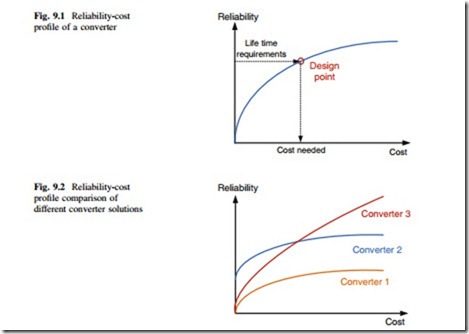In a traditional wind power converter design process, the power switching device ratings are normally decided based on the potential current/voltage stresses, and some rating margins may be reserved to ensure certain reliability requirements. However, it is found that the loading distribution of power devices may be quite unequal under various converter topologies as well as operation conditions [1–4]. With this traditional “rating-oriented” design process, it may easily lead to capacity waste of some less loaded devices. Therefore, more advanced models for wind power converter design are needed in order to satisfy the growing reliability requirements together with the most cost-effective solutions.
If the relationship between the reliability and corresponding cost of power semiconductor for a wind power converter is related, as indicated in the curve of Fig. 9.1, the “just-right” device cost/ratings can be determined according to the specific reliability requirements by the mission profile. With this reliability-cost model and the “reliability-oriented” design process, it is possible to enable more accurate and cost-effective design for the wind power converter achieving the target reliability requirements.
With the reliability-cost performances profiles, it is also possible to unify and compare different converter solutions in a more sensible way, as demonstrated in Fig. 9.2 (i.e., converter solutions with different topologies, voltage ratings, switching frequencies, etc. for a given mission profile). Therefore, a new reliability-cost evaluation benchmark for wind power converters can be established and help to guide the selection of various converter solutions.
As a result, this special topic will focus on the development of such models which can relate the reliability and cost of power switching devices for wind power converters, and it is different from the system-level reliability-cost analysis in [5]. In order to easier quantify the reliability and cost performances, as shown in Fig. 9.3, the reliability is represented by the power device junction temperature mean value Tm and fluctuation ΔTj according to the manufacturer’s life-time models for power semiconductors [6–10]. The cost is represented by the used chip or cell numbers
N in IGBT/Diode modules according to the dominant packaging structure by IGBT manufacturers [11, 12]. Consequently, the relationship between the reliability and cost of converters is transferred to the relationship between junction temperature and chip numbers of power switching devices.
According to the widely used loss and thermal models for power switching devices in [7, 13– 15], the junction temperature is generated by applying the losses to the thermal impedance. Therefore, the key method to relate the junction temperature and chip numbers of power devices is to include the chip number information into the loss model as well as the thermal impedance model, respectively.
